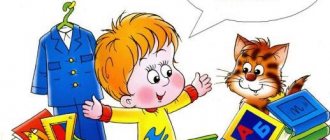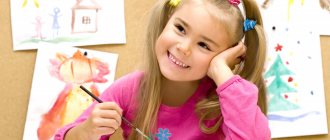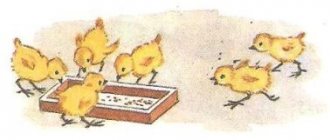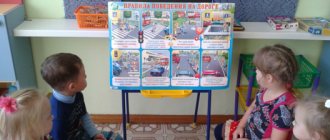- Does your baby absolutely not want to look at the letters in the alphabet?
- Is your child about to start first grade, but can he be forced to read only under pain of being “excommunicated” from the computer?
- Don’t know how to organize classes with a preschooler in such a way as to save your nerves and not completely discourage his interest in reading?
These and other problems in teaching preschoolers to read can be solved by organizing classes in a playful way.
For preschool children, play is the leading form of activity. Therefore, engaging with a preschooler by playing different games is the easiest and most effective way to teach him to read. Before we talk about what games are best to play with your child when learning to read, we will give some general tips on organizing classes.
- Exercise regularly! Let the classes be short (5-10 minutes), but daily. This is much more effective for preschoolers than 45-minute lessons once a week.
- Exercise everywhere. To learn to read, you don't necessarily have to sit your child at a table with books. You can learn letters in the park while taking a walk, drawing them with chalk on the asphalt or looking at signs, helping mom make cookies in the shape of letters, or studying license plates of cars in the parking lot, etc.
- Exercise when your child feels well: he has slept, is active and is ready for new games and activities.
- Constantly create situations of success for your child, praise him more often, focus his attention on what he has accomplished, and do not dwell on failures. Classes should be a joy for the child!
And one more thing you definitely need to know when starting to learn to read is in the article at the link.
What games can be played at different stages of teaching preschoolers to read?
How to understand when it's time
To the question “When is it time for a child to learn to read?” There is no ready answer, but we would like to immediately warn against two misconceptions:
- “You don’t have to teach your child to read at home; they will teach you at school anyway.” Alas, they won’t teach - school teachers simply don’t have time to teach every child to read correctly. Already in the first lessons you will have to read books, textbooks, and inscriptions on the board. Not being able to read, a first-grader risks immediately falling behind his classmates and losing interest in learning.
- “There is no time to waste - the sooner the baby starts reading, the better.” All children are different and develop at their own pace. Therefore, you should not impose learning to read on a preschooler as soon as he is 4–5 years old, if the student himself does not yet show interest in this activity.
The indicator that you should focus on is not the age of the preschooler, but his speech skills.
It's time to learn to read if...
If a preschooler has already developed a sufficient vocabulary to chat with adults, if he constructs sentences grammatically correctly, understands and uses phraseological units in his speech, then the child is ready to learn to read.
Without a sufficient grammatical foundation and vocabulary, learning to read will be difficult. It is critical that the child understands the meaning of the words and phrases he reads, otherwise learning will not be productive. Therefore, if the child is not yet very confident in speaking, do not rush him into reading - this will not help develop speech, but will only demotivate him.
Exercises with words: strengthening the skill
As soon as the child learns to merge letters into syllables, parents can be congratulated for being halfway through the journey. Now the most important thing is to consolidate the acquired skill. In this case, fun and interesting tasks will be used.
| What to play | What to do |
| Who eats what? | Write the names of the animals in the column: CAT, KO-RO-VA, SO-BA-KA, BEL-KA, RABBIT, MOUSE. And to the right and left of the words, draw pictures: fish, grass, bone, nut, carrot, cheese. The child’s task is to read the word and “feed” each pet with the right food using the arrows. |
| Who's the odd one out? | Write a few words in a column: GRU-SHA, YAB-LO-KO, A-NA-US, PO-MI-DOR. Ask your child to cross out the extra word, and be sure to explain his choice. This way you can play with the names of vegetables, clothes/shoes, flowers, trees, birds, etc. |
| Big and small | Write the words DE-RE-VO, GO-RA, GRU-ZO-VIK, ZHI-RAF, I-GO-DA, DROP-LA, BU-SI-NA at the top of the sheet. Below, draw two pictures - a house (big) and a chicken (small). Let the child read the words, determine which ones are big and small, and connect them with lines to the matching pictures (a berry, a drop and a bead for a chicken, the rest of the words for a house). In a similar way, words can be divided into sweet and sour, heavy and light, etc. |
| Who lives where? | Write down the names of wild and domestic animals mixed together: WOLF, ELK, LI-SA, KA-BAN, KO-RO-VA, KO-ZA, CAT, SO-BA-KA, HEDGEHOG. Under the words, draw a forest on one side, and a village hut with a fence on the other. Let the child read the words and use arrows to depict where each of the animals lives. |
How to make learning to read easier for a preschooler
Praise more and never scold
It’s hard for us adults to imagine how difficult it really is for a child to learn such a complex skill as reading from scratch. After all, to be able to read means to be able to correlate a sound with a letter or combination of letters, to understand the meanings of the words read and the meaning behind the text.
If parents take the child's successes for granted and express dissatisfaction when the child does not understand something, this will not push the student to develop, but will only complicate the process. Therefore, it is important to praise for small victories: I learned the letter that we studied last time - great, I coped with a word with as many as two syllables without my dad's help - smart girl.
Do not perceive failures as a consequence of the little student’s negligence. When a child does not understand the first time, this is a reason to look for another explanation or give more time to practice. If you feel tired and irritated, you should stop the activity and return to it in a good mood.
Exercise little by little but regularly
You shouldn’t expect your child to be perseverant and willing to spend hours figuring out unfamiliar letters. It is difficult for preschoolers to maintain attention in a lesson for longer than 25 minutes, and even such small lessons should be interrupted with physical education and games so that the child does not get bored. This is exactly how preparation for school is structured at Skysmart: 25-minute classes with breaks for outdoor games.
But regular practice is important - much more important than the duration of the lesson. And these don’t have to be just lessons: you can look for familiar letters on signs while walking, on a door sign in a children’s clinic, on the packaging of your favorite corn flakes.
Read books aloud
In a series of studies conducted by Dr Victoria Purcell-Gates on five-year-olds who were not yet able to read, it was found that those children who were regularly read aloud by their parents for two years expressed ideas in more literary language, constructed longer sentences and used more complex syntax .
In addition, reading aloud with adults helped expand children's vocabulary, as parents explained the meaning of new words that children had not encountered in everyday life.
Expert opinion
According to neuroscientist Marianne Wolfe, evenings spent reading with parents help foster a love of reading because children develop a connection between reading aloud and feelings of love and warmth.
Discuss what you read
The role of communication in teaching literacy is difficult to overestimate. At first, it is important to ask if the student is interested, if he is tired, and what he remembers from the lesson. When a preschooler learns to read coherent texts, be sure to ask questions about their content.
It’s great if a child reads independently and without parental encouragement, but even in this case, do not deprive him of the opportunity to discuss what he read with you. For example, you could ask:
- Who was your favorite character?
- Do you think this heroine is like you? Would you like to be like her?
- What would you do if you were the hero?
- Why did the described event happen? How are these two events related?
- How did what you read make you feel?
- What do you remember most from what you read?
- What do you think the author wanted to teach? Why did he write this? Do you agree with the author?
Go from simple to complex
From the correspondence between sounds and letters - to syllables, from short words - to longer and more complex words. It would seem that this is obvious, but no: sometimes parents are so happy with the child’s success at first that they push him to study more complex topics than he is ready to accept. Of course, the program should be tailored to the student, but you should not skip steps, even if the child is making progress.
There are methods that suggest teaching a child to read by memorizing whole words. Unfortunately, experiments show that such methods generally work worse. For example, a group of scientists from the United States came up with an artificial alphabet and asked subjects to learn it, and then read words written using this alphabet. At the same time, some subjects were immediately explained the principles of correspondence between sounds and letters, while others had to deduce the rules of reading on their own based on whole words. It turned out that the first group copes with reading new, previously unfamiliar words better than the second.
Therefore, we advise you to choose teaching methods that provide clear instructions about the connection between sounds and letters - and this is especially important for those children for whom reading is difficult. Below we have collected several such techniques that you can use to homeschool your preschooler.
First steps to reading: getting to know the letters
To teach a child to read, it is necessary to maintain an interest in books and letters from an early age. As a rule, at 2-3 years old children begin to show attention to the alphabet. It is very important for parents to provide the right developmental space at this moment.
Visualization
A child will remember the letters quite quickly if a bright poster with the Russian alphabet is in his field of vision. The baby points to the letter - say the corresponding sound. You may have to return to “A” and “B” more than once and repeat them, but this is how your baby will remember them faster. For busy parents, an interactive panel with letters will be a good help - it itself sounds the letter that the child clicks on.
Touch
To memorize the letters of the alphabet, it is important for a child to use his sense of touch. To develop your child’s abstract thinking, invite him to get acquainted with letters molded from plasticine or cut out of cardboard. Pay attention to the similarity of objects and letters - the horizontal bar looks like a “P”, and the donut is the spitting image of the letter “O”.
Tea party by letters
The process of learning letters will be very fun and tasty if you offer your child an edible alphabet. Using curly pasta, you can cook Abvgdeyka soup, and for dessert, bake your own homemade alphabet cookies.
Magnetic entertainment
With the help of a magnetic alphabet, you can turn the process of learning letters into a fun and memorable game. For example, 1-2 year old children can be lured by simply attaching a letter to the surface of the refrigerator and saying it. “Give me the letter! What do we have? This is the letter A! If your child is already 3 years old, he will enjoy playing “magnetic fishing.” You need all the magnetic letters in a container, and make an impromptu fishing rod from a stick and string with a magnet. Having caught a “fish”, pronounce its name, drawing an analogy with the word. “This is a fish! Look how much she looks like a beetle!”
By keys
Children love to imitate the actions of adults. Let your child press buttons in an open text editor to his heart's content - he will be interested in the letters appearing on the screen. Show me how to type the simplest word “mother”. You can print out the first letter and give it to your child. Even if there is a completely unthinkable combination, this will be a kind of impetus for memorizing the alphabet. Also, to master letters, you can give your child an old computer keyboard to “tear to pieces.”
Methods of teaching preschoolers to read
Warehouse reading
The method of teaching a child to read through warehouses was actually used back in Rus', but for modern parents this technique is associated with the name of the philologist Nikolai Aleksandrovich Zaitsev.
Zaitsev suggests not focusing on learning individual letters, as it can be difficult for students to understand how letters can merge into syllables and words. Teaching a child to read by syllables is also not always easy: one syllable can be quite long (glitter, ruble), and the boundaries of the syllables may not be obvious (Lun-tik or Lun-ntik?). Therefore, in Zaitsev’s methodology, a warehouse is used as the main unit.
The warehouse can be a combination of a consonant and a vowel letter (pa-pa, ma-ma), a separate consonant or vowel (de- d , ya-s-li , A -lyo-sha), as well as a combination of a consonant with a hard or soft sign ( ma- l -chi-k, let's go ).
In order for a preschooler to understand the differences between the recording of voiced and soft, vowel and consonant sounds, different types of frets have their own cube size, color and filling, which makes the cubes sound when shaken. The cubes affect several channels of perception at once, and the sequences need to be sung, not just pronounced - this way, according to the author of the method, learning is more interesting and effective.
One of the advantages of the method is that children willingly play with blocks themselves, and the process of learning to read becomes active and mobile.
Syllable reading
This technique was developed by Nadezhda Sergeevna Zhukova, a Soviet and Russian speech therapist. The basic unit in her system is not a letter, but a syllable. The author of the method suggests moving on to studying letter combinations as soon as the child has mastered the first vowels - a, o, u. When the preschooler has learned to connect two vowels, he can move on to studying consonants.
Thanks to the fact that the concept of a syllable is introduced at an early stage, teaching a child to read syllables together becomes faster and easier. By the way, as in Zaitsev’s method, the syllables are suggested to be sung, and not just pronounced.
Based on the syllabic method, Zhukova developed a set of teaching aids - a primer, copybooks and a reading book. The manuals will help teach children 6 and 7 years old to read correctly at home.
Both techniques for teaching preschoolers to read are used in Skysmart's school readiness course. The course consists of two stages: first, children become familiar with letters and spellings, which allows them to quickly start reading simple words, and then they learn what a syllable is. Gradually we introduce more complex syllable structures and move on to reading phrases and sentences.
When can you start teaching your child to read?
There are several opinions about when you can start teaching your child to read. Some experts believe that you can start certain work, for example, showing Doman cards (we will talk about them and other methods in the second lesson), when the baby reaches six months of age, while others believe that it is best to start at 3-4 years , and precisely from the ABC book. However, all teachers agree on one thing: no teaching of reading is completely unacceptable and impossible until the child has mastered speech skills. If, around the age of 3-4, the child begins to take an active interest in books, it is not only possible, but also necessary to begin learning to read.
It is also worth noting that if you show restlessness and indifference to printed materials, before learning, you should understand how to arouse the child’s interest in reading. We will touch on this issue in more detail in a separate lesson, but we will still say that in solving this problem, parents will be helped by an incredible selection of books that stand out, in addition to brightness and colorfulness, by the presence of many moving elements and even sound. Thanks to this, reading becomes not just an interesting activity for children, but also an exciting game. At the initial stage, any book serves not so much as a source of knowledge, but as a way to become familiar with the reading process itself.
Continuing the conversation on the topic of a child’s readiness to read, it can be determined by several criteria:
- Firstly, the baby has already formed speech, and he is able to pronounce words and sentences, as well as compose at least small coherent stories
- Secondly, the child does not have speech therapy disorders, and this applies to both incorrect pronunciation and violations of the melody and tempo and rhythm of speech
- Thirdly, the baby is able to navigate normally in space, and does not confuse the concepts of “right”, “left”, “down” and “up” with each other.
- Fourthly, the child has sufficiently developed phonemic hearing, i.e. he can easily recognize sounds in different parts of words
If problems are observed with any of the above, you should begin to eliminate them - spend some time working on the issues causing difficulty, visit a speech therapist, neurologist, etc. If everything is in order (or after the problems have been eliminated), you can move on to learning to read.
Exercises for learning to read
Letter memorization exercises
The first step is to teach your child to recognize letters. To do this, you can use pictures with hidden letters. We use such exercises in our pre-school lessons at Skysmart.
Ask your child to identify which letter a word begins with or to name as many words as possible that begin with a particular letter.
Next, we train ourselves to distinguish correctly written letters from incorrect ones. This is also important for learning to write: preschoolers often mirror letters or distort individual elements.
Vowel and consonant exercises
Tasks in which you need to determine what sound a word begins with will help you learn to distinguish vowel sounds from consonants.
Finding the extra letter will also help you remember the difference between vowels and consonants.
Word Forming Exercises
When the child can already read short words, invite him to form a word from letters on his own.
It’s convenient to form words from syllables if you have cubes at hand, but you can try it on paper.
Another good exercise is to fill in the missing letter in a word. Children complete such tasks during lessons at the Skysmart online school.
Even more bright and fun exercises for learning to read are in the school preparation course from Skysmart. Attentive teachers will help your child learn to read, count and express himself through creativity. Classes are held online at a time convenient for the child and parents. Try it for free with an introductory lesson!
Learning letters.
If a child has trouble remembering letters, the best way to learn them is to “revive” them, to create a vivid association with each letter. You and your child can come up with what this or that letter looks like, or use a variety of materials from the Internet and modern alphabet books.
For example, bright, memorable images of letters for children can be found in Elena Bakhtina’s primer (this book contains not only colorful pictures and recommendations on how to tell a child about each letter, but also colorful templates - letters from this primer can be cut out and played with) .
On the Internet, you can find a lot of coloring pages for children with letters similar to this or that object.
It is also useful in the process of learning letters to repeat short verses that help you remember each letter:
You see the tail at the end, so this is the letter C.
The letter B is like a hippopotamus - She has a big belly!
G looks like a goose - the whole letter is bent.
D - a tall house with a roof! This is the house we live in.
And the poor letter Y walks with a stick, alas!
In my work, I use various “reminders” that children associate with one or another letter. You can actively use them in home lessons or come up with your own.
It is very useful to have a special notebook or album in which the letter you have learned will “live” on each page. In this album you can also teach your child to write, paste pictures with words on the desired letter, add poems and coloring pages, creating a selection of materials for each letter. Children are very fascinated by the process of joint creativity, so actively involve them in creating such an album.
Another option is to make a letter house. Choose any size: it can be very small, made from a couple of cardboard sheets, or huge, as tall as a child. The main thing about it is the special pocket windows for letters. In each “apartment” of the letter house, place a letter with your child. To do this, you will need cardboard letters slightly smaller than each window. Mark in any way which apartments already have “residents” and which ones are still empty.
Attach the already learned letters to the outside of the windows (using paper clips) and invite the child to arrange pictures with words into the studied letters in the windows. For example, “treat” the letters: give the child images of products that he must distribute to the desired “apartments”: put a watermelon/apricot in the window with the letter A, a loaf, an eggplant - in the window with the letter B, waffles / grapes - with the letter B and etc.
Similarly, you can visit letters with fairy-tale characters (Pinocchio - to the letter B, Thumbelina - to the letter D, Mowgli - to the letter M, etc.), “dress” the letters (take the T-shirt to the letter F, jeans to the letter D, pants - letter Ш, etc.).
The main goal of this game is to teach the child to identify the first letter in a word and easily recognize letters already completed.
Various lotto and domino games are also great for learning letters. It is better to use lotto without picture prompts, this way learning will be much more effective. You can easily make such a lotto yourself. To do this, prepare sheets with 6-8 pictures on each and cardboard cards with the necessary letters. Let the child draw cards, read the letters and show which player has the picture for the dropped letter.
From simple to complex
Speed reading training is based on the ability to perceive words as a whole, without dividing them into syllables. At the initial stage, use short words consisting of two or three sounds. For example, “house”, “cat”. In the future, the baby will not read them or recognize them by letters. He will see this word in the text and immediately pronounce it. This is the meaning of the speed reading technique.
Preparation for the lesson: write the simplest words on a piece of paper, one at a time. Show them one after the other. As you complete the exercise, gradually increase the pace of changing words. Replace three-letter lexemes with words of four–five–seven letters after a solid assimilation of the material covered.
Words (“house”, “forest”) are replaced with complex ones (“tree”, “car”), then phrases and phrases. Compose sentences from vocabulary familiar to students. For example, he can read “who” and “house” separately. Suggest the phrase: “Who is in the house,” then add “lives” to this. You will get an offer.
You can start reading short texts when the student has mastered the ability to quickly read phrases and phrases. The pace of skill consolidation is different for all children. Do not rush if the student hesitates. Sometimes you need to return to simple, already covered material. This will increase interest in classes, reduce emotional stress, and set you up for success.
And only in this case will the fast reading technique produce results.
Important! For your first books, use bright literature, with pictures, and an interesting plot. A boring curriculum will not do.






